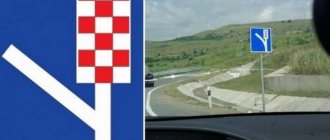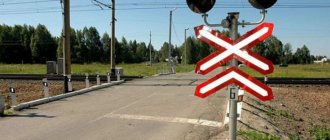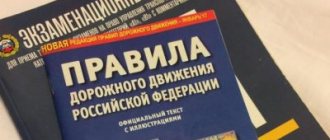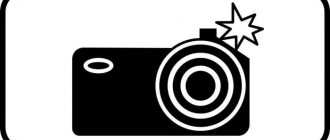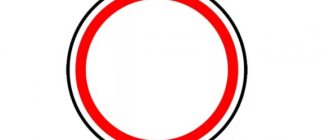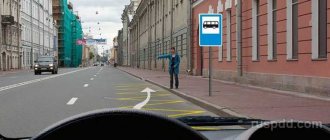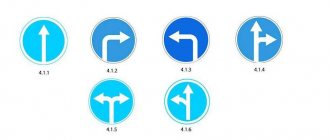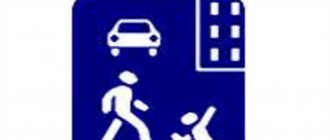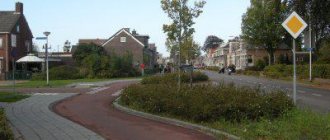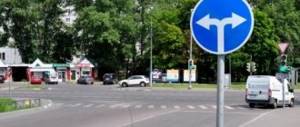The importance of knowing road signs cannot be underestimated, since they provide the driver with comprehensive information related to road traffic.
These information images indicate what is prohibited, what is allowed on a given section of the road, inform and warn the driver about the danger.
They are divided into nine groups:
- Warning. As the name suggests, the purpose of these types is to inform about dangers on a section of the road in order for the driver to take appropriate measures to ensure the safety of themselves, passengers and pedestrians.
- Priority signs. Indicate to drivers the order of passage through narrow road sections and intersections.
- Prohibiting. Appropriate traffic restrictions are introduced and also lifted.
- Prescriptive. Establish mandatory driving conditions on a lane or section of road.
- Special instructions. Designed to organize a certain traffic mode, or cancel it.
- Additional Information. These are signs used in conjunction with other types, complementing or clarifying the actions of the latter.
- Information types.
- Identification varieties.
- Service.
Below we will look in detail at the “No Parking” type, which is classified as prohibiting, so first we will take a closer look at this broad group.
Prohibiting varieties
Outwardly, it is very simple to distinguish them - a circle with a red border on a white or blue background, which is quite difficult not to notice. This is a very large group that regulates literally all aspects of road traffic, starting from the maximum permissible speed, restrictions on the weight and types of vehicles, and ending with the ban on entry, parking and stopping of cars on various sections of the road.
It is important not only to confidently imagine what prohibitory signs look like and what exactly they prohibit, but also to understand exactly on which sections of the roadway they operate, that is, to imagine the area of effect of the sign. Let's first figure out where the zone of action of the prohibiting species begins.
Regarding the lanes to which it applies, everything is also quite simple - prohibitory signs only apply to one side of the road, where they are installed.
Of course, there are exceptions to any rule. So, for example, the “Parking is prohibited” type, established at the entrance to the yard, does not apply to persons living in the house or working in an organization located here, if a detour is not provided. There are other exceptions related to the action of this sign, which will be discussed below.
Sign No parking
This road symbol can be found very often - a blue circle with a red border, crossed diagonally by one red stripe. It is clear that it prohibits parking of vehicles on any day of the week.
But sometimes you can find it prohibiting parking, for example, only on odd days, or even days - on them one or two white stripes (vertical) are drawn inside a crossed out circle. Accordingly, one lane is crossed out - you cannot park a car only on odd days, two - on even days.
However, there are restrictions here too - the ban is valid only until the evening - until 19.00, so in order not to break the rules, before 21.00 the vehicle must be driven to the other side of the road - as a rule, a sign with a reverse restriction is installed on it.
Well, in the period from 19.00 to 21.00 you can park your car in the coverage area of any sign - you will not break the rules. It should also be noted that there are categories of people who can safely ignore the “Parking Prohibited” symbol.
We will not describe in detail the rules for federal postal vehicles, for which this type does not apply - this is not relevant for us. It is much more important that cars of disabled people of groups I and II and persons transporting such disabled people can park under this graphic element without fear.
No parking or stopping sign
This type, so to speak, is closely related to the road sign we described above. The fact is that where stopping is prohibited, parking is also prohibited, but not vice versa.
What will happen to the ruble, dollar and euro in the summer? Currency forecast
At the beginning of summer, the ruble exchange rate is usually stable. Just remember last June, when the dollar was 68 rubles and the euro 77. And this was in the midst of a pandemic. AiF.ru learned from financial experts what awaits the Russian currency this summer.
Article on the topic The pursuit of the digital ruble. How giving up traditional money will change our lives
Nikolay Mrochkovsky, associate professor of the Russian Economic University. G. V. Plekhanova :
“The general trend in the near future is growing vaccination and, accordingly, a reduction in quarantine risks, which leads to an increase in demand and oil prices. This serves as an additional factor supporting the ruble. The ruble is also supported by the depreciation of the dollar due to financial support programs and low US interest rates.
A less significant, but also supporting factor for the ruble is the lack of tourist demand for the currency. However, with the lifting of quarantine measures and the restoration of tourism, this factor may weaken.
Fundamental economic factors behind the strengthening of the ruble. If oil prices are quite high in the summer, the dollar may cost 72-74 rubles and possibly lower. However, unexpected political or sanctions actions could worsen the situation at any time, and the dollar exchange rate against the ruble could rise again.”
Vladimir Tregubov, Ph.D. Sc., Associate Professor, Department of National Economics, EMIT RANEPA under the President of the Russian Federation, personal finance consultant :
“Usually in the summer, the number of travelers and business traffic increases, which causes an increase in demand for oil and its products, which means that in this area, positive factors influencing the ruble exchange rate remain. However, this is only true if OPEC+ can keep oil production and exports at current levels.
The interest rate policy of the Bank of Russia also speaks in favor of strengthening the ruble. If interest rates in the West remain at the same low level, this will lead to carry-trade - making money on the rate differential and an influx of foreign currency into the country, which will support the ruble. In addition, the Russian Ministry of Finance will purchase less foreign currency to replenish the National Welfare Fund. If in April purchases amounted to 8.4 billion rubles, then in May they will drop to 6.5 billion rubles - this will undoubtedly strengthen the ruble.
From the point of view of technical analysis, the ruble against the dollar is in a growing triangle, that is, a strong strengthening of the ruble cannot be expected globally, and this would not correspond to the goals of the monetary authorities.
All of the above is true if we do not see new “black swans”, a correction or collapse in financial markets, a deterioration in relations with Western partners, etc.”
Mikhail Kogan, head of the analytical research department of the Higher School of Financial Management:
“All forecasts for the ruble, not only for several months in advance, but also for several weeks, depend on politics. Packages of sanctions, stopping the construction of Nord Stream 2 - all these factors can affect the Russian currency more than the third wave of the pandemic or oil prices, to which the ruble was actually tied for the last few years, but now the rise in prices for raw materials has no impact on the national currency exchange rate are not reflected.
Question answer
How did the dollar rise in price from 6 to 78 rubles? Infographics The situation may change closer to the State Duma elections. While the world is restoring the economy and the external background is relatively calm, the ruble may strengthen to 72-73 rubles per dollar and 85 rubles per euro. As soon as real pressure begins, the rate may sharply reach 80 rubles per dollar and 95 per euro.
It should be a relatively quiet summer in major political arenas. Attention will be focused on neutralizing the third wave, vaccinating the population, and holding postponed public events. In addition, the United States has a sufficient number of current internal issues that the Biden administration will focus on unless new provocations begin politically and regarding the situation around Ukraine and Donbass.
It can be assumed that the best option for the ruble in the next few months will be banal silence. This factor, high oil prices and a change in the vector of the Central Bank’s monetary policy towards increasing the key rate can support the ruble at the level of 72-73 per dollar.”
Dmitry Panov, Chairman of the St. Petersburg regional branch of Business Russia:
“The key factors for strengthening the ruble exchange rate this summer, in our opinion, will be:
— weakening of geopolitical risks in the prospect of waiting for a meeting between the presidents of Russia and the United States, relieving tension in the southeast of Ukraine and resolving diplomatic conflicts;
— the impact of an increase in the key rate of the Central Bank of the Russian Federation on an increase in the yield of Russian government bonds and a decrease in monthly inflation rates;
— an increase in oil prices caused by the continuation of existing OPEC+ restrictions and a slight increase in seasonal demand.
At the same time, the geopolitical situation in the world today is quite unstable, and any deterioration could affect the exchange rate of the Russian currency towards its increase in relation to both the dollar and the euro and other currencies. There are also still risks of the coronavirus pandemic intensifying in large regions consuming petroleum products, especially in India, and the associated decline in oil demand, which will also negatively affect the ruble exchange rate.
Taking these factors into account, the expected range of the ruble exchange rate in the summer is from 74 to 77 rubles per dollar.”
Ruble trick. What can a country gain from denomination? More details
Natalya Pavlova, investment and financial consultant:
“In the coming months we will see a slight strengthening of the ruble due to several events. Among them: rising oil prices, the weak impact of US sanctions on Russia's national debt, an increase in rates by the Central Bank and a slowdown in inflation, as well as closed borders for holidays abroad.
All these factors together will allow the ruble to remain at 73-75 against the dollar and 88-92 against the euro by summer. The deterioration of relations between the Russian Federation and the United States, as well as in the event of an increase in demand for foreign currency due to the easing of quarantine measures and the opening of borders, will lead to a weakening of the ruble to 78 against the dollar.”
Alexandra Bazak, independent financial advisor:
“There are two factors influencing the ruble. The first is the geopolitical situation—confrontation with Ukraine, Europe and the United States with statements about tough financial sanctions. Following Joe Biden’s hopeful proposal to Vladimir Putin for a meeting on “neutral territory,” the ruble will strengthen slightly.
The second factor is inflation, which is currently experiencing difficult times all over the world. All this significantly affects government bonds and the ruble in general in a not very positive way.
Given the current state of affairs, I assume that in the summer the dollar will strengthen around 75-77 rubles.”
Warning signs
This category is distinguished by the fact that a significant part of the designations is framed by a red triangle. In this way, they seem to focus the attention of the road user on a possible danger, which, in turn, is pointed out to them. Of course, the designation system includes the most common options for dangerous sections of the road. Movement along them requires maximum concentration and timely adoption of measures to stabilize the situation. For example, this could be an intersection with a railway, tram tracks, traffic control with traffic lights, dangerous turns, road surface features, permitted pedestrian movement, repair work, the possibility of animals appearing, and so on. If you see an exclamation mark in a red triangle, you should remember that such a designation includes the so-called “other hazards”. These are all kinds of threats to the further successful and stable movement that are not provided for by other symbols.
Priority signs
It should be remembered that not only in the previous category there is such a symbol as the red triangle. The sign is also included in the priority group. Here, a similar symbol also serves to attract the attention of the driver of the vehicle. A red triangle in the context of this category warns of the intersection of a main road with a secondary one, as well as the junction of the latter. It is important to remember that rapprochement can occur both on the right side and on the left. Let's look at another important question. What does an upside down red triangle mean? This symbol is called “Give way” and means that a traffic participant heading towards the intersection with the main road along a secondary road must take all necessary actions so as not to impede the movement of other drivers.
Location
As mentioned earlier, the red triangle is most often found in warning signs, the main purpose of which is to alert the driver to possible dangerous situations on the road. Consequently, the traffic rules describe the need to install it at a certain distance before the start of the suspicious area. Within a populated area, this value ranges from 50 to 100 meters, and outside it varies from 150 to 300 m. In some cases, additional installation of a special sign called “Distance to object” is provided, where the required value is displayed. In addition, if the dangerous area is quite long, it is also possible to install an “Area of Action” sign, which is installed under the corresponding warning symbol.
Road sign 1.6 “Intersection of equivalent roads”
- Traffic Laws
- Traffic signs
- Fines
- traffic police
- Obtaining a driver's license
- Vehicle registration
Traffic signs Warning signs Road sign 1.6 “Intersection of equivalent roads”
An intersection is a place of increased danger for both drivers and pedestrians. After all, traffic flows moving in different directions intersect here, and it is very important to adhere to all the rules related to traffic at the intersection in order to avoid accidents.
Intersecting roads can be of equal or unequal significance. The approach of an intersection with equivalent roads is signaled to the driver by road sign 1.6 “Intersection of equivalent roads , which is a black cross, the crossbars of which are placed diagonally, depicted on a white background and enclosed in a red triangle.
This sign means that roads that intersect are of equal importance, regardless of the road surface.
The first thing a driver must do when he sees such a sign is to slow down, since it is very likely that he will have to give way to vehicles moving on the right. And even if he always drove along the road designated as the main one at previous intersections, still at the intersection in front of which there is a sign 1.6, he will have to give way to cars moving on the right.
Rail transport, for example, a tram, also has an advantage at intersections with equivalent roads. Drivers of vehicles promise to always let him through, no matter from which direction he moves.
Sometimes it happens that sign 1.6 “Intersection of equivalent roads” is not installed in front of intersections. This can happen in rural areas or low-traffic city lanes. In such cases, it is important to be able to read the intersection and sort out priorities. In any case, it would be a good idea to let traffic moving on the right pass, and, having passed the intersection, pay attention to the sign that is installed in front of it.
At intersections marked with sign 1.6., a situation may arise when each driver has an obstacle on the right. In this case, drivers must decide their own driving order. For example, by briefly switching the high-low beam headlights. This signal means “I’m the last to go.” This means that you will not be a hindrance to other drivers.
A sign notifying the driver of the approaching intersection with equivalent roads, like other warning signs, is installed in the city at a distance of 50 - 100 meters before the intersection, outside the city - at a distance of 150 - 300 meters before the intersection. The difference in distance is explained by the fact that on country roads, drivers reach higher speeds and take longer to slow down.
Important to remember
If any sign is located on a yellow background, this means that it is temporary. In relation to warning symbols, this may mean that the danger has arisen relatively recently, and road authorities have not yet had time to take measures to eliminate it. If you saw a red triangle on a yellow background and identified it as a priority sign, then it is likely that repair work is being carried out somewhere along your route. They were the reason for the change in movement on this section of the road. Of course, we should not forget that if there are regular and repair signs, it is imperative to comply with the requirements of the latter.
Release forms
Currently, all signs included in traffic regulations are made on a metal base, which is coated with a special reflective compound. This makes the sign visible at any time of the day. In some cases, LED contour lighting may be used. It is provided either by miniature incandescent lamps or the more common LEDs.
The revision came into force on November 5, 2014.
Changes were made in accordance with Decree of the Government of the Russian Federation dated October 24, 2014 No. 1097.
Warning signs inform drivers that they are approaching a dangerous section of the road, driving along which requires taking measures appropriate to the situation. The numbering of road signs corresponds to GOST R 52290-2004.
Priority signs establish the order of passage through intersections, intersections of roadways or narrow sections of the road.
Prohibition signs introduce or remove certain traffic restrictions.
Compliance with the requirements of prescriptive signs is mandatory if traffic management is not carried out by a traffic controller.
Special regulations signs introduce or cancel certain traffic modes.
Information signs inform about the location of populated areas and other objects, as well as established or recommended traffic modes.
Service signs inform about the location of the relevant facilities.
Additional information signs (plates) clarify or limit the effect of the signs with which they are used.
Identification signs or plates serve to limit or clarify the effect of the sign with which they are used.
Information about road signs
A road sign, or traffic sign, is a graphic design made in accordance with certain standards and installed near the road in order to bring certain information to the attention of road users.
The role of road signs in ensuring traffic safety is extremely large: they inform drivers about dangerous sections of the road, oblige them to reduce speed, prohibit overtaking where it is associated with an increased risk, and perform many other useful tasks. Modern standards that determine the appearance of road signs, as well as markings and traffic lights, came into force in our country on January 1, 2006. The updated signs are fully compliant with the UN Convention on Road Signs and Signals and the latest European standards in the relevant field.
The traffic rules, which regulate in detail issues related to road signs, define eight categories:
- warning: they are triangles with a white background, red border and black drawings. Designed to warn traffic participants about danger;
- signs of priority right of way: determine the order of passage of bottlenecks and intersections;
- prohibitory and restrictive signs: made in the form of a white circle with a red border and a black pattern. Prohibit certain actions;
- mandatory signs: have a round shape, blue background and white drawings. Prescribe the performance of certain actions;
- signs of special regulations;
- information signs: have a rectangular shape and blue (sometimes green) color. Used to inform traffic participants about the location of lanes, the nature of the road, service companies and much more;
- information and directional signs;
- additional signs (plates): supplement the main signs listed above, never used separately. They have a rectangular shape and a white background; the design and edging are black.
The current version of the Traffic Rules determines the priority of signs over road markings. If markings and road signs contradict each other, the driver must be guided by the requirements of the latter.
Warning road signs
Good afternoon, dear reader.
In this article we will talk about warning road signs, which can often be found on domestic roads. Let me remind you that the traffic rules include a whole appendix that describes all kinds of road signs.
The number of road signs is quite large, and it is not possible to consider them in a single article. Therefore, from today on pddmaster.ru a new series of articles “Road Signs” begins to be published, which will discuss the features of the use of absolutely all road signs.
For example, in this article we will look at the first part of the Warning Signs chapter. Among others, we will consider a dangerous turn sign, a railway crossing sign, a steep climb sign, an exit sign to the embankment and many others. Let's get started.
I note that within the framework of this article, road signs will be given exactly in the sequence in which they are described in the rules of the road.
First, let's look at the features that are inherent in all warning road signs.
1. Traffic warning signs, by definition, do not prohibit anything, so it is impossible to violate their requirements even theoretically. Those. You will not be able to receive a fine for violating the requirements of a warning sign (you can obtain information about the amount of the fine for violating the requirements of other road signs using the traffic police fine table).
Nevertheless, you should not relax, because... Warning signs are very often installed in front of sections of the road where you can receive fines for violating certain points of traffic rules. For example, we are talking about a dangerous turn sign, which will be discussed a little later.
2. Almost all warning signs are a triangle with red sides and a white middle.
3. Warning signs in the form of a triangle are installed at a distance of 150-300 meters outside populated areas, and at a distance of 50-100 meters in populated areas before the start of a dangerous section of the road.
In addition, if there is a plate 8.1.1, triangular signs can be installed at a different distance from the beginning of the dangerous section.
Some warning signs should be duplicated, but we will talk about this feature a little later.
Railway crossing sign
There are several road signs to indicate railroad crossings. You can find a detailed discussion of these signs in the article “Railway crossing and its boundaries.”
Here we will only consider their most basic features:
1.1 "Railway crossing with a barrier."
1.2 “Railway crossing without a barrier.”
1.3.1 “Single-track railway”, 1.3.2 “Multi-track railway”. Designation of a railway crossing not equipped with a barrier: 1.3.1 - with one track, 1.3.2 - with two tracks or more.
1.4.1 - 1.4.6 “Approaching a railway crossing.” Additional warning about approaching a railway crossing outside of populated areas.
Any of the signs listed above informs you that you are approaching a railway crossing.
Triangular signs 1.1 and 1.2 are repeated outside the populated area. In this case, the second sign is installed at a distance of at least 50 meters before the crossing
Signs 1.3.1 and 1.3.2 help you determine the boundaries of a railway crossing if it is not equipped with a barrier. Information about the boundaries of the crossing is very important, because Special traffic rules apply directly at the crossing. For example, stopping and parking there is prohibited.
Tram line intersection sign
The intersection with the tram line sign is installed in settlements where tram traffic is organized:
The only action you should take after you encounter a 1.5 sign is to be especially careful. The fact is that the weight of any tram is several tens of tons, so in any collision with a passenger car, the main damage will be caused to the latter.
Therefore, in practice, it is better to give way to the tram even when it is traveling in violation of traffic rules.
Sign of intersection of equivalent roads
The intersection of equivalent roads sign warns you that an intersection of equivalent roads will soon appear on the road:
Let me remind you that at an equivalent intersection you must give way to cars approaching the intersection from the right.
You can find out more about the rules for driving through intersections in the article “Transition through unregulated intersections of equal significance.”
Roundabout sign
A roundabout sign warns you when you are approaching a roundabout:
Naturally, such a sign is not installed in front of every roundabout intersection.
Traffic light regulation sign
A traffic light regulation sign warns of approaching a section of the road where traffic lights are installed:
In practice, this sign is usually used when traffic lights are installed at an intersection or pedestrian crossing that has been unregulated for many years.
This was done in order to warn drivers who, out of habit, may not notice the newly installed traffic lights. So if you come across a 1.8 sign on the road, pay attention to it. Most likely you will encounter a traffic light in an unexpected place.
Also, a traffic light regulation sign must be installed in front of traffic lights in populated areas if the visibility distance of the traffic light is less than 100 meters.
Drawbridge sign
The drawbridge road sign warns of approaching a drawbridge or a ferry crossing:
No matter how strange it may sound, cars in Russia continue to fall into rivers with enviable regularity, so sign 1.9 should not be ignored.
The drawbridge sign is duplicated outside populated areas (the second sign is installed 50 meters before the drawbridge).
Exit sign to the embankment
The embankment warning sign warns the driver that his car is approaching the shore of the reservoir:
The exit sign to the embankment, like the previous one, is duplicated outside populated areas.
Dangerous turn sign
The dangerous turn sign shows that there will be a dangerous turn on your way in the near future. The dangerous turns sign has almost the same meaning:
If you see one of the above signs on the road, then you should immediately remember paragraph 11.4 of the traffic rules. Let me remind you that this paragraph states that overtaking is prohibited, including on dangerous turns.
For overtaking on a dangerous turn, the driver will be subject to a license deprivation for a period of 4 to 6 months.
Please note that only signs 1.11.1 - 1.12.1 warn that the next turn will be dangerous. Those. There is no other way to obtain information about the danger of turning.
I would also like to remind you that if overtaking was completed before the start of a dangerous turn, or started immediately after it, then this is not a violation of the rules (of course, if there are no other prohibiting conditions).
This article discussed warning road signs 1.1 - 1.12.1. We will talk about the next group of road signs in one of the following articles.
Good luck on the roads!
pddmaster.ru
